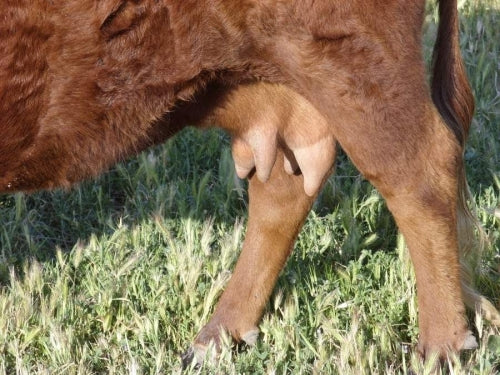
Dr. Colleen Lewis / December 14, 2016
Normally, a cow’s teats are cylindrical and maintain a constant diameter from top to bottom. A calf can easily slip a normal teat into its mouth from any angle. A carrot teat is an abnormal teat that is larger at the base and conically narrows towards the teat end, or sphincter. This carrot shape is due to the breakdown of the elasticity of the teat. One or two teats may be affected, or all four. As a cow nears the end of gestation and each quarter fills with colostrum, the pressure of the early milk begins to stretch out the shape of the teat. At the time of calving, a carrot teat is often very full and very turgid. Many calves cannot get their mouths wrapped around a carrot teat and are in danger of not getting enough milk and acquiring failure of passive transfer (FPT).
If a cow only has one carrot teat, a calf may be content to ignore it and just nurse off the other three. Studies in dairy cows show that three teats can produce as much as 85% of the original milk supply with a compensatory mechanism. So ultimately, the calf will be able to survive on 15% less milk, but may not reach its full growth potential. When a teat is not nursed on, the residual milk left behind can become contaminated and result in a mammary infection, mastitis. The damage to the infected quarter may be serious enough to kill the quarter, never to produce milk again. Mastitic milk can be caused by bacteria such as coliforms or salmonella that can be very dangerous to the cow and calf. These bacteria produce toxins that can cause illness and death.
Hand milking out a cow that has carrot teats and feeding it to her calf has two great benefits. First, the calf is receiving a known quantity of colostrum, thereby preventing FPT. Second, the milking eases the pressure and diminishes the large size and crazy shape of the teat. Once the teats are empty of milk, the base diameter reduces considerably in size. The teats become much easier to pull into the mouth. Now, the calf might be able to simply keep up with the milk supply and prevent the teats from becoming large and turgid again. It depends on how much the cow produces and how much the calf is consuming.
One thing that you can definitely depend on: carrot teats will not resolve from one lactation to the next. They will be most problematic at the time of calving, yet hardly noticeable at the time of breeding. Without proper documentation and record keeping, they are often forgotten. But once the cow calves again, the teat in question goes back to its carrot ways. Once a carrot teat, always a carrot teat. Nice, cylindrical teats are heritable; carrot teats are heritable. Selecting and culling for teat shape can help to avoid problems with carrot teats and subsequent problems in your herd. Cows with good udder quality versus carrot teats will require less labor, enjoy improved longevity due to a decreased incidence of mastitis, provide better passive transfer, and raise more pounds of beef with greater milkability.

About the Author
Dr. Colleen Lewis is a 1996 graduate of Kansas State University, College of Veterinary Medicine. Her career has taken her to many places as a practice owner, consultant, embryologist, and mentor. She enjoys mixed animal practice, teaching, traveling, farming and high school sports with her husband, Andrew and their three boys.




